User Equipment

User equipment for safe working at height is formally known as PFPE (Personal Fall Protection Equipment) and is usually characterised as “harnesses and lanyards”, though there are many more types of PFPE than just these two.
PFPE is a form of PPE, as it is carried or worn to the workplace, which connects the worker to the anchor system adequately securely to resist the high loads generated when a fall is arrested. This strength performance is a requirement even where systems are designed for Work Restraint.
The PFPE should also include adequate energy absorbing capabilities to limit the peak force generated during the arrest of a fall. Again, this energy absorbing capability is recommended even where systems are designed for Work Restraint.
There are three main groups of PFPE types:
- Harnesses,
- Attachment Systems,
such as Lanyards, Rope Grab Systems & Retractable Fall Arresters, and - Rescue Systems
There are various standards which cover the design and testing of each type of equipment and these are discussed further below.
For clarity, the scope of these notes does not include Rope Access (abseiling) where a higher degree of competency in selection and use of PFPE can reasonably be expected, due to the formal training and assessment available.
Harnesses

Harnesses are devices, usually comprising an assembly of webbing straps, designed to hold a human body and provide a means of connecting it to an Anchor System, via an Attachment System, to form a Fall Protection System.
There are many different models and types of harness, but apart from specialist applications, only Full Body Harnesses should be used for fall protection. There is variation in their design and cost, with different features intended for different applications, but there are some features common to all fall protection harnesses.
The harness should fully and securely hold the worker’s body, such that it cannot be accidentally released during a fall arrest. The harness straps should pass over the shoulders and close across the chest, such that the shoulder straps cannot slide down the arms. Straps should also pass between the legs at the groin, with a strap beneath the backside. The harness should be fitted tightly enough that there will be no significant migration of the straps in a fall arrest, but not so tightly that the worker’s movements are restricted.
All harnesses should have an attachment point, located centrally at the back of the worker’s torso, between the shoulder blades. For many applications this is the only attachment point required and is referred to as a Dorsal Attachment Point. All Attachment Points on harnesses should be clearly labelled ‘A’.
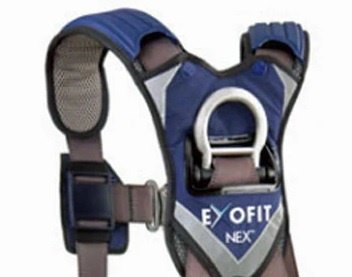
Workers cannot see their Dorsal Attachment Point and many find it difficult to reach, hence for many applications it is recommended to use a Dorsal Extender, which allows the worker to see and reach the connection to the Attachment System. This allows the worker to attach and detach without help from a colleague.
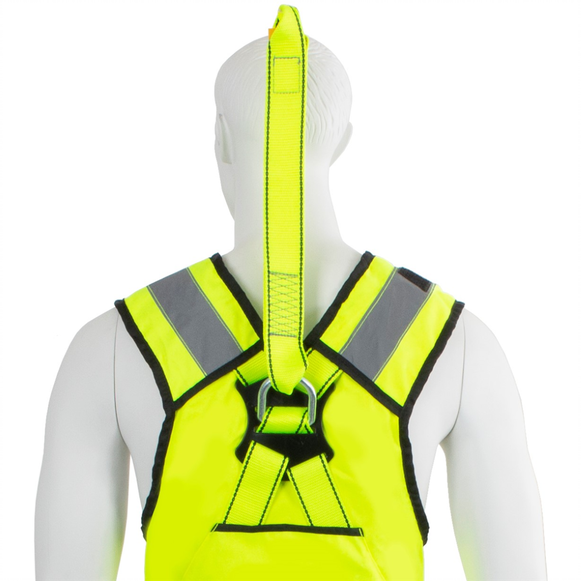
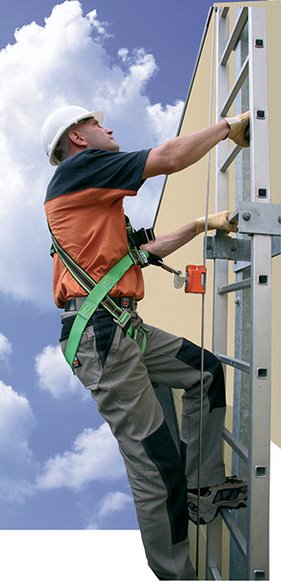
Where vertical fall protection systems are to be used, an attachment point located centrally at the front of the torso will also be required. On some designs of harness, the front attachment point comprises two separate D-rings, which must always be used in combination, by joining them together when connecting to the attachment system. If only one of these D-rings is used, then the worker could suffer serious injury in a fall arrest due to the eccentric loads applied to the body. Rope Access workers will also use harnesses which have front attachment points. This is referred to as a Ventral Attachment Point.
Where work positioning systems are to be used, side D-rings, at the hips may also be required. The D-rings must not be used for Fall Arrest or Work Restraint, but only for Work Positioning.
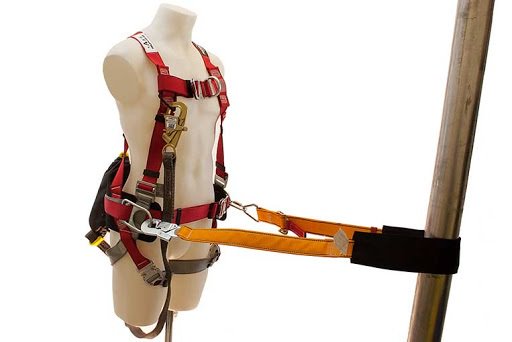
Lanyards
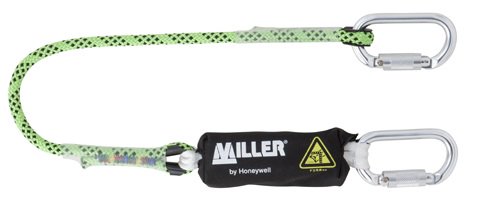
Lanyards are the simplest type of Attachment Systems, usually made from a textile webbing or polyamide rope. There should be a connector (usually a karabiner) at each end, to allow attachment to the Harness and to the Anchor System.
Lanyards have a maximum length of 2 metres and can be fixed length for adjustable in length.
Lanyards are available with or without integrated Energy Absorbers. These elements are an essential part of Fall Protection Systems, as when a high tensile load is applied to them, they will deploy and extend in length, resulting in a softer arrest and lower loads applied to the worker and to the Anchor System. European Energy Absorbers are designed to limit the arrest to loads to a maximum of 6kN. It is recommended that Energy Absorbers are used in all Fall Protection systems and there is no significant reason not to do so.

Rope Grab Systems
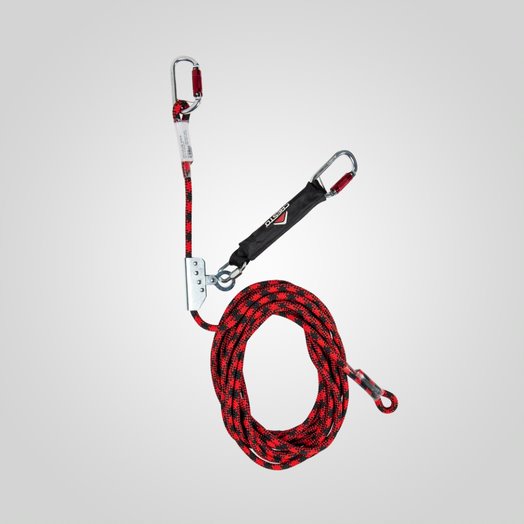
Rope Grab Systems are an alternative to Lanyards, as a means of connecting between the Harness and the Anchor System.
They are commonly used in horizontal applications, such as on roofs to permit a wide range of movement by the worker. However, it is important to be aware that these systems were originally designed for vertical applications, such as protection while climbing ladders, and the European standard for these systems only assesses their use vertically. There would normally be a significantly greater free-fall distance in a horizontal application compared to a vertical one and therefore any Rope Grab System which complies only with the European standard, should not be used horizontally. Additionally, when used horizontally, the system will usually bear against the edge of the roof, which again is outside of the scope of the European standard. There is an additional set of assessments which Rope Grab Systems should demonstrate satisfactory performance against, if they are intended to be used horizontally. These additional assessments are referred to in the Standards section below. Acceptable horizontal use of any Rope Grab System should be unequivocally stated by the manufacturer in the User Instructions, if this is not the case then the system should not be used horizontally.
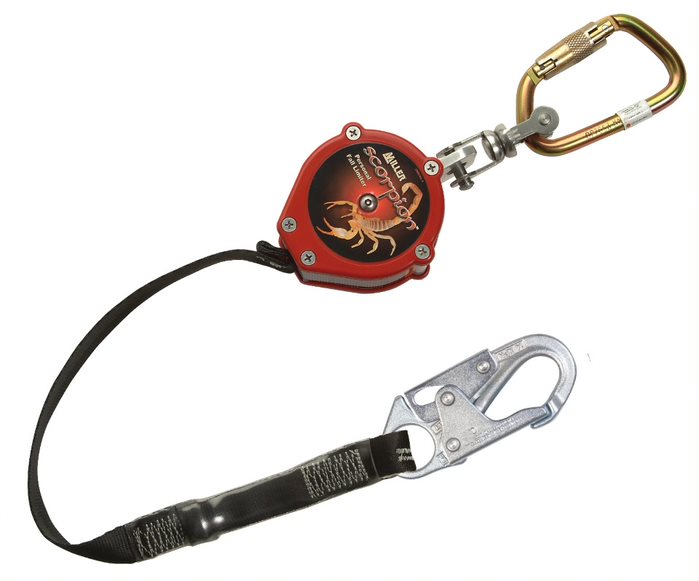
Retractable Fall Arresters
Retractable Fall Arresters are also commonly referred to as “Inertia Reels”, “Blocks”, “Fall Arrest Blocks” or “SRLs (Self-Retracting Lifelines)” and are sometimes described as “car seat belt type” devices.
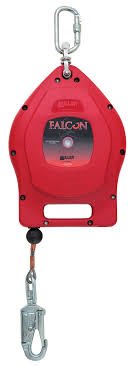
These devices are available in a wide range of lengths: some short ones (less than 2m) which are lightweight and can be “worn” attached to the Harness; others are mid length and practically need to be attached to the Anchor System by the worker; longest ones are not man-handleable and are usually permanently mounted high overhead.
The lines within these devices are usually formed from webbing or steel cable, depending on intended application and/ or weight requirements.
Some devices are designed to be left in harsh environments long-term, but more commonly they should be stored as other PFPE would be.
These devices are a type of Attachment System which automatically shortens and minimises the length of the connection between the Harness and the Anchor System. This is usually beneficial as it means that the height of any fall will also be minimised.
Generally, these devices are designed and have been assessed only for use where the anchor system is above the worker and the manufacturer will specify a maximum angle from vertical at which the device will work safely.
Normally, these devices should not be used in horizontal applications. However, there is an additional set of assessments which Retractable Fall Arresters should demonstrate satisfactory performance against if they are intended to be used horizontally. These additional assessments are referred to in the Standards section below. Acceptable horizontal use of any Retractable Fall Arrester should be unequivocally stated by the manufacturer in the User Instructions, if this is not the case then the device should not be used horizontally..
Connectors
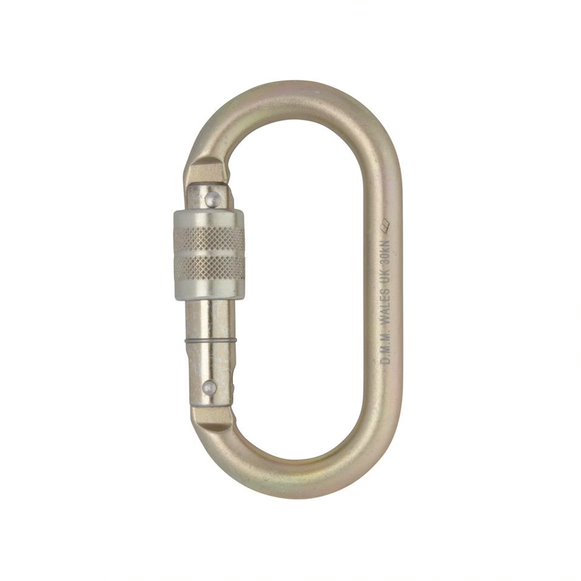
Each of the parts of a PFPS are normally connected together using karabiners, though there are several other types of connector.
All connectors should be suitable for their intended use and in good condition.
Generally, for lower competency workers, auto-locking karabiners should be used as this significantly reduces the risk of a worker failing to lock a karabiner before use.
Rescue Systems
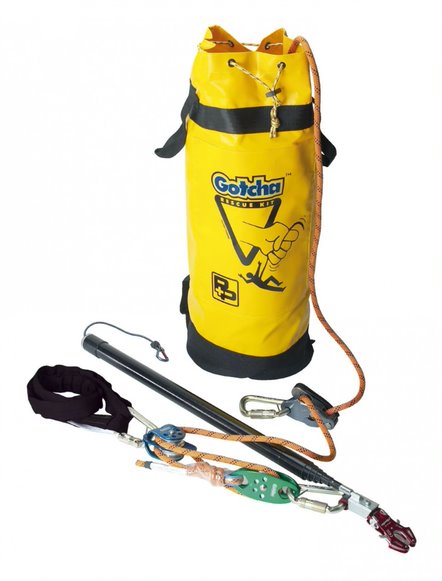
It is a requirement, so as reasonably practicable, to prevent workers from falling from height, but this is not always possible. Whenever there is a possibility of a fall from height occurring a worker must have an effective fall arrest system. And where a fall arrest system is used there must be an effective emergency rescue plan in place to recover the suspended worker after the fall.
The rescue plan should be developed by the System Designer, to ensure all required provisions are included within the PFPS. Any specialist equipment required to implement the rescue plan should be immediately available at the place they may be required. A rescue plan should enable a suspended person to be recovered within 10 minutes, to minimise possible medical issues related to suspension in harnesses. All workers should be competent in the use of the rescue system.
A rescue plan should always be included in the task-specific RAMS.
When presented with the need to perform a rescue, the rescuer should follow three general steps in order:
- Raise the alarm
summon assistance even if it is believed further help may not be required. Time is short and additional assistance can only help and it may arrive too late if not summoned immediately - Protect themselves
the risk of falling must be minimised, a second falling worker may have no potential competent rescuer close-by or sufficient equipment to perform two rescues - Deliver the rescue
Most rescue systems require operation by a second worker. Generally, they involve connecting a secondary system to an anchor and to the suspended worker’s harness. It should be ensured that if the anchor system to be used for rescue is the same as the one to which the suspended worker is attached, then any expected deformation of the anchor system in arresting a fall still allows for its safe and effective use for rescue purposes. There are various means of remotely connecting the rescue system to the harness, telescopic poles or rope grabs are two such options.
Once the suspended worker is connected to the anchor through the rescue system, it is normal to use the rescue system to slightly raise the suspended worker such that their original fall arrest system goes slack, demonstrating that they are now suspended by the rescue system. The fall arrest system can then be disconnected.
Previously ‘cut rescue’ techniques have been used, these should not be used as there is a significant possibility that the fall arrest system could be cut before the rescue system is effectively connected and this means the suspended worker could fall.
With the suspender worker supported solely by the rescue system, it is normally simplest to lower them down to a safe area below. If this is not possible, then it will be necessary to raise them up to where a rescuer can safely recover them back into a safe area. Thought should be given as to how an injured and/ or unconscious person can be brought over the edge of a roof or platform without further injury or risk to the rescuer.
The rescue plan should include all steps necessary to place a casualty in area which is safe for paramedics to attend them.
Rescue systems for use with PFPS normally specifically pre-prepared collections of PFPE. They are normally supplied in kit bags, which are sealed in a tamper resistant and evident way. This is done to ensure the full kit is available in good condition when needed. However, it is good practice to ensure workers who may be expected to use the rescue system to periodically rehearse use of the rescue system on the ground, with no risk of a fall. This could be done during a toolbox talk session every few months. On completion of the rehearsal, the kit should be re-assembled and re-sealed by a competent person.
Applicable Standards & Guidance
| Term/Acronym | Description / Definition |
| BS 7883 | Personal fall protection equipment. Anchor systems. System design, installation and inspection. Code of practice |
| BS 7985 | Code of practice for the use of rope access methods for industrial purposes. Recommendations and guidance supplementary to BS ISO 22846. |
| BS 8437 | Code of practice for selection, use and maintenance of personal fall protection systems and equipment for use in the workplace |
| BS 8454 | Code of practice for the delivery of training and education for work at height and rescue |
| BS 8610 | Personal fall protection equipment. Anchor systems. Specification |
| CNB RFU 11.060 | Testing of retractable type fall arresters for use horizontally over an edge |
| CNB RFU 11.074 | Testing of lanyards with energy absorbers for use horizontally over an edge |
| CNB RFU 11.075 | Testing of guided type fall arrester with flexible anchor line for use horizontally over an edge |
| EN 341 | Personal fall protection equipment. Descender devices for rescue. |
| EN 354 | Personal fall protection equipment. Lanyards |
| EN 355 | Personal protective equipment against falls from a height. Energy absorbers |
| EN 358 | Personal protective equipment for work positioning and prevention of falls from a height. Belts and lanyards for work positioning or restraint |
| EN 360 | Personal protective equipment against falls from a height. Retractable type fall arresters |
| EN 361 | Personal protective equipment against falls from a height. Full body harnesses |
| EN 362 | Personal protective equipment against falls from a height. Connectors |
| EN 363 | Personal fall protection equipment. Personal fall protection systems |
| EN 364 | Personal protective equipment against falls from a height. Test methods |
| EN 365 | Personal protective equipment against falls from a height. General requirements for instructions for use, maintenance, periodic examination, repair, marking and packaging |
| INDG 367 | Inspecting fall arrest equipment made from webbing or rope |
| INDG 401 | Work at height regulations – brief guide |
Design Considerations
The specification for PFPE to be used as part of any Personal Fall Protection System should be given by the System Designer and included within the System Technical File and the User Instructions.
The System Designer should consider the competency of the expected End Users and ensure that the PFPE specified allows the expected work tasks to be undertaken safely by the expected End Users and their expected competency level.
Any foreseeable misuse of the PFPS should be mitigated by the System Designer, including the specification for PFPE.
Provision for emergency rescue plans should be included in the design of the PFPS, particularly the availability and suitability of anchor systems for rescue in all locations where there may be a fall arrest.
User Considerations
The manager of any Work at Height activity must ensure that workers are competent, i.e. have adequate knowledge, skills, and experience, in the safe use of the specific Fall Protection System provided, including the PFPE. Misuse of PFPE can fundamentally undermine the design principles of a PFPS and render the protection provided inadequate.
Competency in work at height is not a binary issue, i.e. it is not as simple as being competent or not for all aspects of work at height. There are various degrees of complexity and risk associated with types of protection and managers should ensure that users of PFPS and PFPE are adequately competent with the equipment to be used, for the work task to be done, in the relevant environment.
User Instructions for the PFPS must be provided and this should include how the specified PFPE can be used to provide safe access for all work tasks to be undertaken.
INSPECTION
Generally, all PFPE should be subject to a formal examination by a competent person at least every 6 months in accordance with Government and industry guidance.
However, for PFPE which is used regularly, this period should be reduced to at least every 3 months.
The formal inspection should be undertaken by a competent person who:
- is sufficiently independent and impartial to make objective decisions
- is knowledgeable of each manufacturer’s requirements for examination
- is capable of assessing defects
- may need to be trained by the manufacturer
These formal examinations should be logged in a register and the PFPE should be marked/ labelled to show that it has been examined.
In addition to formal examinations, PFPE should be inspected by the user before each occasion of use. This should primarily be a visual, tactile and functional check looking for damage or wear.
Any PFPE which is found to have significant defects should be:
- Immediately removed from service
- Rendered unusable, e.g. by cutting it in half with scissors
- Disposed of
All users of PFPE should be trained in the pre-use inspection criteria for the equipment they are using.

